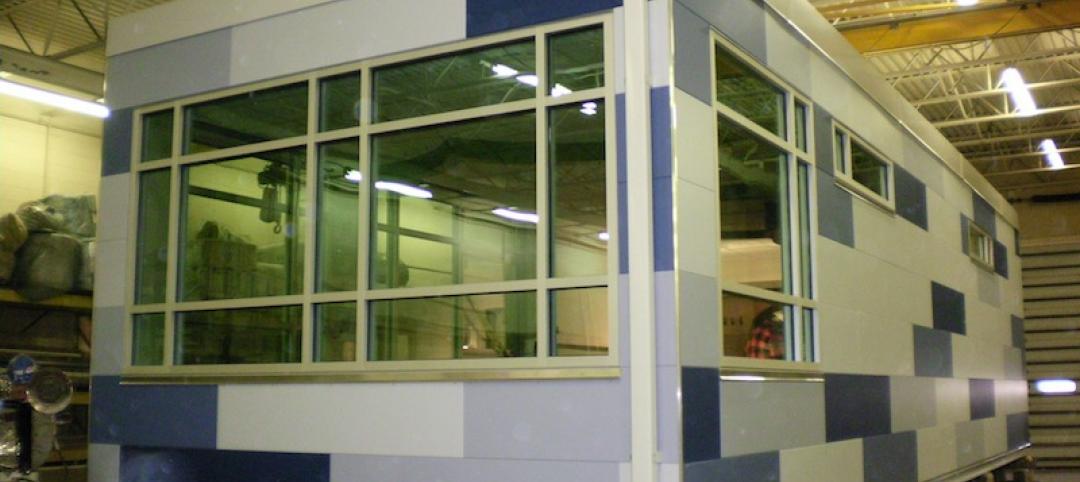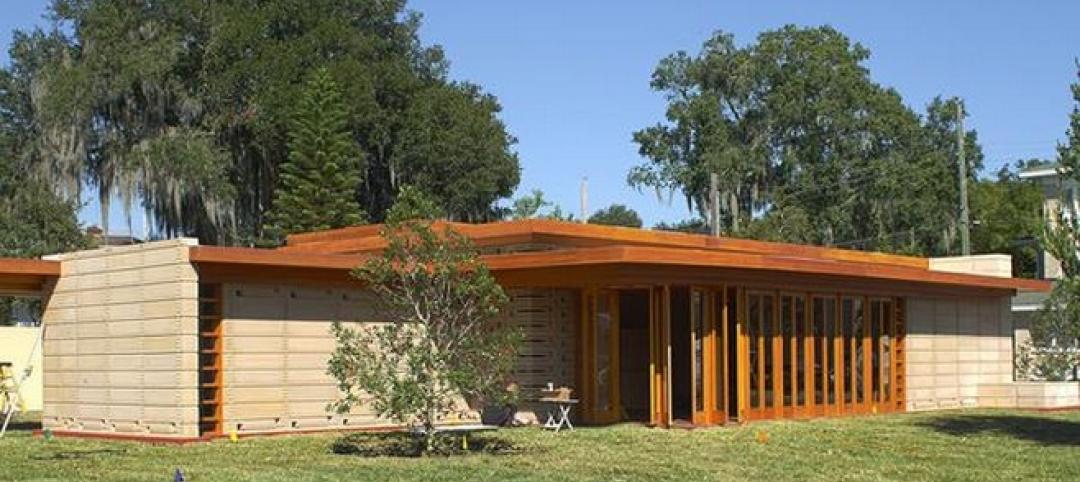
Hospitals are energy gluttons. With 24/7/365 operating schedules and stringent requirements for air quality in ORs and other clinical areas, an acute-care hospital will gobble up about twice the energy per square foot of, say, a commercial office building.
It is an achievement worth noting, therefore, when a major hospital achieves LEED Platinum status, especially when that hospital attains 14 of a possible 17 points for Energy & Atmosphere and 11 of 15 for Indoor Environment Quality.
Kudos, therefore, to Dell Children's Medical Center of Central Texas, a 169-bed, 503,000-sf children's hospital and trauma center in Austin, which gained the coveted top spot in green certification (under LEED-NC 2.1) in early 2009, making it the first LEED Platinum hospital in the U.S.
Phil Risner, PE, LEED AP, the owner's project manager and building systems network engineer, said LEED Platinum was the hospital's goal from the outset because “being green” would have “real, positive effects on both the environment and our healthcare delivery capability.”

Wishing is one thing; executing is another. How the Building Team tackled the difficult energy and IEQ problems of such a facility may provide valuable instruction to AEC professionals facing similarly complex situations.
“We had three guiding principles,” recalls Joseph F. Kuspan, AIA, SVP and design director at Karlsberger, the Columbus, Ohio, firm that did the master plan and design for Dell Children's. “One, don't do dumb things to get LEED points. Two, anything less than a 12% return on investment is dumb. And three, we had to know if we were being dumb.” That is, before rejecting any strategy—roof-mounted wind turbines, for example—the team had to weigh it seriously to see whether or not it was truly viable.
A boon from Austin Energy
Dell Children's sits on 32 acres within a 700-acre brownfield redevelopment site that was once home to Austin's municipal airport. To provide power to the new facility, the local utility, Austin Energy, built an $18 million combined cooling/heating power (CCHP) plant. This increased the energy efficiency of the primary fuel conversion for the project from roughly 29% in a conventional power service model, to 75% efficiency.
The CCHP also saved $6.8 million in capital costs that would have gone to boilers, emergency generators, cooling towers, chillers, and the space necessary to house them. The bulk of the savings, $5.8 million, was plowed back into energy-conservation measures and other LEED initiatives.
Equally important to the sustainability of the project was its use of courtyards, which not only opened up the building massing (and played nicely into the project's pace-setting daylighting strategy), but also led to an interesting approach to the hospital's air handling units.

“The owner wanted the AHUs to be in enclosed spaces, not on the roof,” to simplify maintenance and extend their life expectancy, says Kuspan. Instead of doing the usual 10% space gross-up for the mechanical system, the designers put the air handling units in 2,000-sf “rooms” distributed across 15 locations. “We stacked those rooms and put five heat recovery rooms on the roof, because we didn't want to lose that 70° air on a 100° day in Texas,” he says. “That allowed some of the floors below to use that 70° air.”
Each “stack” of AHU rooms was also right-sized to meet the needs of the hospital department it served. One stack might serve a cardio OR, where the room temperature has to be jacked up from 60°F to 90°F in a matter of minutes following surgery, while another stack might serve administrative offices, where the room temperature would be fairly constant.
This innovation produced further benefits and cost savings, says Kuspan. It allowed for shorter duct runs, which enabled the Building Team to overscale the ducts to reduce air velocity and noise. “That kind of background noise can be a stress factor for patients, families, and staff in a hospital setting,” says Kuspan. The designers were also able to reduce the size of fan motors, thereby saving on initial cost as well as operating expenses.
The project's glazing also had to be fine-tuned to achieve a delicate balance between achieving energy savings in the hot Texas sun and not distorting the view to the outdoors. “The grid that was established in the [master] plan was on a 37-degree angle, which was great for some things but tough for sun control,” says Kuspan. Seton Healthcare Network wanted to avoid any hint of a “techy” look on the exterior; therefore, no applied exterior shading devices, no sunshades, no vertical blades, and definitely no motorized systems.
The team solve this problem by using high-efficiency, double-e coated glass high up on the walls and clearer glass, with low-level coatings, in what Kuspan calls “the sweet spot” from three to seven feet above the floor, where greater transparency was called for.
Perhaps the most commendable aspect of Dell Children's, though, is what the Building Team and hospital board didn't do. They stuck to their principles and didn't go overboard to look super-green. Design elements that could have added LEED EA or IEQ points but failed the “don't do anything dumb” rule or fell below 12% ROI didn't make the cut—things like active photovoltaics, roof-mounted wind turbines, vegetative roofs, natural ventilation in the lobby, charging stations for electric vehicles, and a biofuel fueling station for fleet vehicles.
Many other non-energy-related design elements were also scratched, things like denim wall insulation, waterless urinals, an on-site tertiary water treatment plant, pervious pavement and bioswales in the parking lot, a 500,000-gallon rainwater cistern, and recycled gypsum board. All were struck from the program, even though they might have added LEED points.
In some cases, otherwise popular sustainable design elements were ruled out by the owner. For example, interior light shelves were vetoed by the hospital because they were seen as dust collectors and a potential infection control threat. Even without light shelves, however, the Building Team was able to use the open spaces in the courtyards to daylight more than 80% of occupied administrative and nonclinical spaces. Perhaps more remarkable was their ability to get daylight into 35% of diagnostic and treatment areas. By using the LEED “alternative compliance path,” the project was able to earn the first LEED point for daylighting by a hospital.
Of course, not everything worked as planned. Motion sensors were used extensively to control lighting use, but this went a bit too far when the motion sensors in the on-call room kept turning the lights on every time the residents rolled over in their sleep. These motion sensors were quickly removed. Seton Healthcare's Risner and his staff also had to do a lot of fine-tuning to optimize all the mechanical systems.
By sticking to their guiding principles, however, the owner and the Building Team were able to produce a BMW project at a KIA price. “A lot of people think we must have had an $800 per square foot budget, that's just not true,” says Kuspan. The construction cost was somewhere between $280/sf and $305/sf, depending on whether the $18 million for the cogeneration plant is included in the calculation.
“That's not an exorbitant cost per square foot for a project like this,” says Kuspan. Not when you get the kinds of bragging rights Dell Children's Medical Center has earned.
Related Stories
| Nov 13, 2013
Installed capacity of geothermal heat pumps to grow by 150% by 2020, says study
The worldwide installed capacity of GHP systems will reach 127.4 gigawatts-thermal over the next seven years, growth of nearly 150%, according to a recent report from Navigant Research.
| Nov 11, 2013
The story behind 'Pedia-Pod,' BD+C's modular pediatric patient unit at Greenbuild
In the November issue of BD+C, you'll see our report on "Pedia-Pod," the modular pediatric patient unit we've helped design, outfit, and build at Greenbuild. Here's how it was developed.
| Nov 8, 2013
Can Big Data help building owners slash op-ex budgets?
Real estate services giant Jones Lang LaSalle set out to answer these questions when it partnered with Pacific Controls to develop IntelliCommand, a 24/7 real-time remote monitoring and control service for its commercial real estate owner clients.
| Nov 8, 2013
S+T buildings embrace 'no excuses' approach to green labs
Some science-design experts once believed high levels of sustainability would be possible only for low-intensity labs in temperate zones. But recent projects prove otherwise.
| Nov 8, 2013
Walkable solar pavement debuts at George Washington University
George Washington University worked with supplier Onyx Solar to design and install 100 sf of walkable solar pavement at its Virginia Science and Technology Campus in Ashburn, Va.
| Nov 6, 2013
Energy-efficiency measures paying off for commercial building owners, says BOMA study
The commercial real estate industry’s ongoing focus on energy efficiency has resulted in a downward trend in total operating expenses (3.9 percent drop, on average), according to BOMA's Experience Exchange Report.
| Nov 5, 2013
Net-zero movement gaining traction in U.S. schools market
As more net-zero energy schools come online, school officials are asking: Is NZE a more logical approach for school districts than holistic green buildings?
| Oct 31, 2013
74 years later, Frank Lloyd Wright structure built at Florida Southern College
The Lakeland, Fla., college adds to its collection of FLW buildings with the completion of the Usonian house, designed by the famed architect in 1939, but never built—until now.
| Oct 30, 2013
15 stellar historic preservation, adaptive reuse, and renovation projects
The winners of the 2013 Reconstruction Awards showcase the best work of distinguished Building Teams, encompassing historic preservation, adaptive reuse, and renovations and additions.
| Oct 30, 2013
11 hot BIM/VDC topics for 2013
If you like to geek out on building information modeling and virtual design and construction, you should enjoy this overview of the top BIM/VDC topics.
















